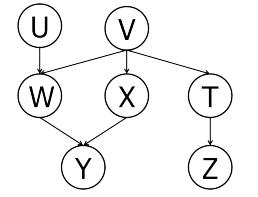a. For the Bayes net in Figure S13.37, we are given the query P(Z | + y).
Question:
a. For the Bayes net in Figure S13.37, we are given the query P(Z | + y). All variables are Boolean. Assume we run variable elimination to compute the answer to this query, with the following variable elimination ordering: U, V , W, T, X. After inserting evidence, we have the following factors to start out with:
P(U), P(V ), P(W |U, V ), P(X | V ), P(T | V ), P(+y | W, X), P(Z | T) .
When eliminating U we generate a new factor f1 as follows:
f1(V, W) = Σu P(u)P(W | u, V ) .
This leaves us with the factors:
P(V ), P(X | V ), P(T | V ), P(+y | W, X), P(Z | T), f1(V, W) .
Now complete the remaining steps:
(i) When eliminating V we generate a new factor f2 as follows:
(ii) This leaves us with the factors:
(iii) When eliminating W we generate a new factor f3 as follows:
(iv) This leaves us with the factors:
(v) When eliminating T we generate a new factor f4 as follows:
(vi) This leaves us with the factor:
(vii) When eliminating X we generate a new factor f5 as follows:
(viii) This leaves us with the factor:
b. Briefly explain how P(Z | + y) can be computed from f5.
c. Amongst f1, f2, . . . , f5, which is the largest factor generated? How large is this factor?
d. Find a variable elimination ordering for the same query, i.e., for P(Z | y), for which the maximum size factor generated along the way is smallest.
Figure S13.37

Step by Step Answer:

Artificial Intelligence A Modern Approach
ISBN: 9780134610993
4th Edition
Authors: Stuart Russell, Peter Norvig





